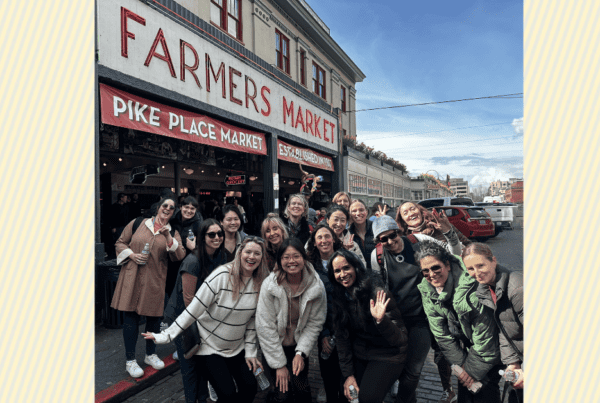Cell phone? Check. Keys? Check. Hand sanitizer and properly donned cloth face mask? Double check.
As Washington begins to reopen, more and more people will be going back to work or school. While this prospect is exciting, it also means an even greater responsibility to practice COVID-19 hygiene and safety measures, including wearing a mask.
Learn how to get the best fit, avoid acne and keep yourself and others safe with these face mask best practices for non-clinical employees from Jan Agosti, MD, an infectious disease specialist at the Allergy and Infectious Disease Division at UW Medical Center.
DO: Wear a cloth face mask when in public
If you’re going to be within 6 feet of someone that you don’t live with, make sure to mask up.
Since April 27, all UW Medicine employees who work in non-clinical areas have been required to wear a face mask while at work. And, effective June 26, wearing a mask while in public — whether you are indoors or outside — is mandatory in Washington state.
Wearing a mask helps protect you from airborne allergens and respiratory illness as well as prevents the spread of COVID-19, Agosti says.
“You should wear a mask even if you don’t have any symptoms, because you could be in the pre-symptomatic stage.”
DON’T: Purchase N95 masks
The CDC recommends cloth face coverings for non-healthcare workers, so avoid purchasing N95 masks, which are in short supply and are needed by our healthcare workers.
UW Medicine can supply you with a cloth face mask if you need one, and departments can purchase face masks for employees through the the Department of Biochemistry as well.
DO: Secure your mask tightly around your face
Place your face mask over your nose and mouth so that it is resting on the bridge of your nose and under your chin.
To avoid slippage, tie your mask higher up on your head or sew on a bendable piece of metal that can form to your nose, Agosti says.
DON’T: Touch or adjust your face mask once it’s in place
This contaminates the mask and can get germs on your hands.
When you do want to remove your mask, touch only the ear loops or strings — not the outside of the face area of the mask itself, Agosti says.
Place your mask in a paper bag for safe (i.e., clean) keeping, and then wash or sterilize those hands.
DO: Clean your face mask after each day’s use
The tried and true, CDC-backed method is to wash your mask in a machine with hot water and laundry detergent or by hand using a bleach solution. Just make sure to remove any paper filters beforehand and to place your mask in a mesh bag if you are machine washing so that the strings don’t get knotted. Dry in high heat or sunlight.
You can also follow the Department of Homeland Security’s instructions for using a multicooker with sous vide settings to sterilize your mask.
And if daily washing is not an option, Agosti notes that leaving a mask in a dry, warm location for 48 to 72 hours (the amount of time the coronavirus lasts on cardboard, the closest studied surface to cloth) before reuse should be a sufficient alternative, although controlled studies haven’t yet been done.
DON’T: Use a tanning bed or hydrogen peroxide to sterilize your mask
Cleaning methods to avoid? Hydrogen peroxide, tanning beds and microwaving a mask, the latter being both unhelpful and a potential fire hazard, Agosti says.
She does note that UVC radiation — like what is used in the UV radiation sanitizers that disinfect electronic devices — can be used to sterilize masks if instructions are followed correctly. But it can depend on the model.
“There aren’t any clear independent standards in place to determine whether consumer-oriented UV disinfection devices are truly effective or that verify manufacturer claims,” Agosti says. “Improper handling of a powerful UV device comes with risk of serious skin and eye damage.”
DO: Take your mask off when you’re eating or drinking
You can wear the same mask after you’ve finished eating, just make sure to wash your hands before and after you touch the mask, Agosti says.
Another pro-trip? Pack a hearty meal and drink lots of water at lunch so you can avoid taking your mask off for snacks throughout the day.
DON’T: Slip a straw underneath your mask
While tempting, this practice lets germs in and out and will eventually distort the shape of your mask.
Instead, make sure to hydrate at lunchtime.
DO: Protect your skin to avoid acne
“This has been seen so much it has a name: maskne,” says Agosti. “Technically, it is acne mechanica from friction that irritates the skin and clogs the pores.”
You can prevent irritation by washing your mask after each use or using a mask with a smoother fabric, she notes.
If you’re still facing pesky pimples, Agosti recommends using a gentle exfoliant to clean your skin or applying a layer of cream or moisturizer where the mask sits on your face.
The cream will help protect against underlying irritation, but …
DON’T: Leave the barrier cream on your skin
“Be sure to wash off any remaining cream or moisturizer after removing your mask,” Agosti says.
By washing off any excess cream, you remove any accumulated bacteria, leaving your skin fresh and clean.
DO: Utilize creative workarounds for glasses, hijabs and ear pain
Prevent your glasses from fogging up by washing the lenses with soap and water and then letting them air dry, which creates a slight film that will prevent fogging. Anti-fog solution and placing folded-up tissues between your mouth and mask can also do the trick, Agosti notes.
If you wear a hijab, she recommends using an extender so that the straps of your mask can tie at the back of your head.
Similarly, to avoid ear pain, use masks that tie in the back or attach the mask’s ear loops to buttons on a headband or surgical cap.
DON’T: Take your mask off to talk
“It happens more often than you would think,” Agosti says.
When talking with a friend, discussing a project with a coworker or even ordering takeout for lunch, you may be tempted to take off your mask or lean across a partition to be better understood.
Avoid these urges and keep your mask snuggly in place.
DO: Play your part to keep our community safe
For those of us who don’t work in a clinical setting, wearing a mask for hours at a time is likely a new experience.
While this may be irritating at first, it’s important to remember that masks are an incredible and essential tool for keeping everyone safe and healthy.
“By wearing a mask, you can feel good that you are doing your part to help contain the pandemic,” Agosti says.


